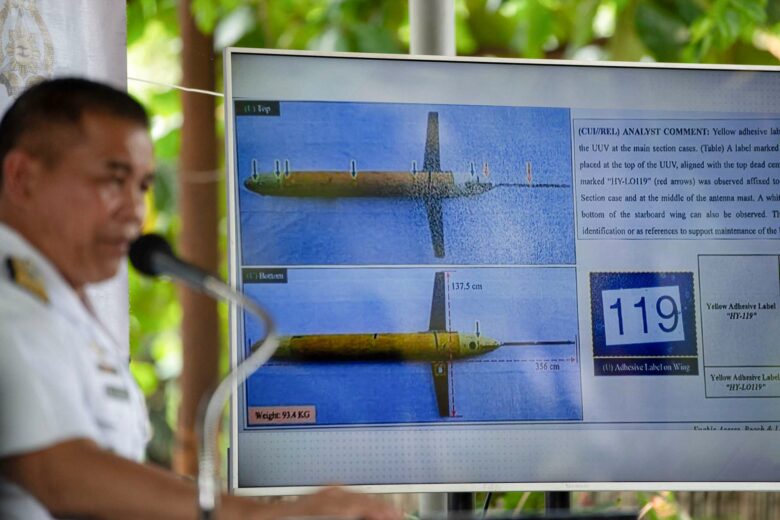The drones were used to collect data for various applications, including for ‘underwater warfare’, a Philippine navy spokesman said
Five aquatic drones of likely Chinese origin recovered in Philippine waters served to collect data for commercial and military applications including for “underwater warfare”, with a
China Telecom
SIM card and components tied to China’s defence industry found in them, a Philippine naval official said on Tuesday.
Three of the drones were recovered last year and the other two were found in 2022, all by local fishermen in areas the navy described as strategic chokepoints in
the Philippines
‘ northern and southern waters.
During a press briefing on Tuesday, Philippine Navy spokesman Rear Admiral Roy Vincent Trinidad spoke about the investigation by local and foreign experts into the drones. One of the drones recovered off Calayan Island in August was of particular interest to forensic analysts as it was “the most intact” and contained a China Telecom SIM card, he said.
Do you have questions about the biggest topics and trends from around the world? Get the answers with
SCMP Knowledge
, our new platform of curated content with explainers, FAQs, analyses and infographics brought to you by our award-winning team.
“The information gathered [by the drone] focuses on mathematic data. It also collects information on sound propagation underwater. All of this information have uses commercially for scientific research, academic purposes, but they have also dual use for military use.”
“Based on the forensics of the SIM card, the last contact that it had was in mainland China,” Trinidad said in reply to a question from This Week in Asia. “That’s the only info we have.”
He said this third drone, like the first one recovered off Pasuquin, Ilocos Norte, in 2022, had acoustic vector sensors. “They were designed not to be retrieved,” he said.
Acoustic sensors are widely used in marine technology, including in underwater navigation and surveillance. Such sensors “play a pivotal role” in detecting ships, submarines and marine life, as well as mapping the seabed, according to a 2024 study in the International Research Journal of Modernisation in Engineering Technology and Science.
Trinidad said all the drones bore “Chinese markings”, but the third unmanned drone stood out for its sensors used to measure conductivity, temperature and depth. Its internal components appeared to have been tampered with, he said. “The integrated chips inside were sanitised or were defaced.”
The drone was also equipped with “an iridium transceiver with serial number HWA-Create. HWA-Create is a company that focuses on defence, civil, government and industrial solutions, the headquarters of which is in Beijing”.
As for the fourth drone recovered off the coast of Initao in Misamis Oriental, southern Philippines, Trinidad said its battery assembly had markings of the 18th Research Institute of China Electronics Technology Group (CETG).
“The CETG Corporation is a state-owned enterprise for civil-military integration of information technology,” he said.
CETG played a central role in integrating civil and military research and operated the Blue Ocean Information Network (BOIN), a project associated with the Communist Party’s efforts to collect marine data in the contested South China Sea, Trinidad added.
“The information that BOIN uses has dual use purposes. They can also be used for military purposes,” he said.
Based on these findings, Trinidad said the report on the drones concluded: “There is a 55 per cent to 80 per cent likelihood that these underwater gliders or drones were made in China. They have the capability to receive, to store, to process, and to transmit data by satellite communications.”
When pressed on their national security implications, he said the drones had “security implications” since the information they generated had “dual use”.
“It’s very clear that these are used for mapping out the underwater terrain, collecting information, like what I mentioned, mathematic data, all of these are used across different fields to include underwater warfare,” he said.
“Any potential adversary who would like to harm our country would need to know the information not only on land and on air, but more importantly, since we are an archipelago, underwater information. These drones give them that information.”
He pointed out that all five drones were found near “strategic sea lanes”. The first three were fished out “a little bit south of the Balintang Channel, which is an international sea lane” in northern Philippines.
The fourth one, found near the Misamis Coastal area last October, was “just west of Surigao Strait, another chokepoint”.
The fifth, found in Masbate province last December, was “just west of San Bernardino Strait, another critical chokepoint”.
Trinidad conceded that the military had no capacity to uncover such devices on its own but had to rely on local fishermen, whom he praised for turning them over to local authorities.
He also told This Week in Asia that the United Nations Convention on the Law of the Sea was silent on the deployment of such drones and “on research for military use”.
More Articles from SCMP
How can Hong Kong reverse growing trend of teens skipping school?
ITTF Men’s and Women’s World Cup Macau: Wang Manyu fights back, Wang Chuqin is ‘lucky’
Chinese snack shop offers to transform placentas into health benefit pills for women
This article originally appeared on the South China Morning Post (www.scmp.com), the leading news media reporting on China and Asia.
Copyright (c) 2025. South China Morning Post Publishers Ltd. All rights reserved.
